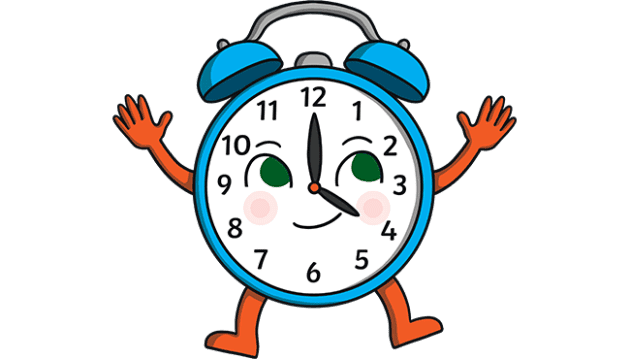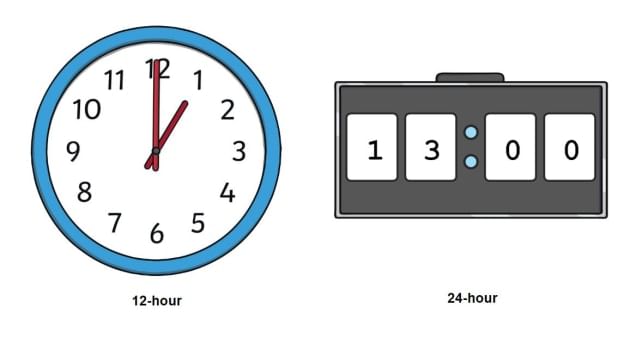Class 4 Exam > Class 4 Notes > Year 4 Mathematics IGCSE (Cambridge) > Chapter Notes: Time and Timetables
Time and Timetables Chapter Notes | Year 4 Mathematics IGCSE (Cambridge) - Class 4 PDF Download
Time

- Focuses on reading and telling the time using both digital and analogue clocks.
- Introduces the use of a.m., p.m., and both 12-hour and 24-hour clock notations for digital and analogue clocks.
- An analogue clock has two scales: one from midnight to midday and another from midday to midnight.
- A digital clock displays time directly, e.g., 13:26 is equivalent to 1:26 p.m. in 12-hour notation.
- Key timekeeping units include:
- Hour: A unit of time, with 24 hours in a day.
- Minute: 1/60 of an hour, with 60 minutes in an hour.
- Second: 1/60 of a minute, with 60 seconds in a minute.
- Students learn to convert between 12-hour and 24-hour clock formats:
- For evening times, add 12 to the hours to convert to 24-hour format, e.g., 6:50 p.m. becomes 18:50 (6 + 12 = 18).
- 24-hour clock times always use four digits, e.g., 08:35 or 20:35.
- Examples of time notation for 6:50 p.m.:
- 6:50 p.m.
- Ten to seven in the evening.
- Ten minutes to seven in the evening.
- 18:50 (24-hour format).
- Historical context: Ancient Egyptians used shadow clocks to measure time, relying on the position of shadows cast by the sun.
- Stage 3 covered 12-hour time notations like "twenty-five to nine," "twenty-five minutes to nine," or 8:35.
- Stage 4 introduces 24-hour notations like 8:35 a.m. (08:35) and 8:35 p.m. (20:35).
Timetables and time intervals

- Focuses on reading timetables to solve problems and calculating time intervals using appropriate units.
- Timetables are essential for planning journeys and ensuring punctuality for events like catching a train, bus, plane, or boat.
- Students learn to interpret timetables to determine:
- Departure and arrival times.
- Duration of journeys.
- Time intervals can be calculated by:
- Adding the time taken between each stop.
- Subtracting the start time from the end time.
- Example: For a coach timetable:
- Anbury (09:09) to Babury (09:24): 15 minutes.
- Babury (09:24) to Corbury (09:45): 21 minutes.
- Total time: 15 + 21 = 36 minutes.
- Alternatively, directly from Anbury (09:09) to Corbury (09:45): 36 minutes.
- Key terminology includes:
- Calendar: A system for organizing days, months, and years.
- Leap year: A year with 366 days, including an extra day in February.
- Time interval: The duration between two points in time.
- Timetable: A schedule showing times of events, such as departures and arrivals.
- Time intervals are calculated using suitable units (e.g., minutes, hours) depending on the context.
- Understanding timetables helps determine the shortest journey time by comparing total durations.
The document Time and Timetables Chapter Notes | Year 4 Mathematics IGCSE (Cambridge) - Class 4 is a part of the Class 4 Course Year 4 Mathematics IGCSE (Cambridge).
All you need of Class 4 at this link: Class 4
|
72 docs|20 tests
|
FAQs on Time and Timetables Chapter Notes - Year 4 Mathematics IGCSE (Cambridge) - Class 4
| 1. What are timetables and how are they used in daily life? |  |
Ans. Timetables are schedules that outline specific times for events or activities, such as school classes, transportation schedules, or work shifts. They help individuals organize their time efficiently, ensuring they know when to engage in particular tasks or when to be at specific locations.
| 2. How can I create an effective timetable for studying? |  |
Ans. To create an effective study timetable, start by identifying your subjects and the time you have available. Break your study sessions into manageable blocks, allocate specific times for each subject, and include breaks to avoid burnout. Use tools like planners or apps to keep track of your schedule and adjust it as needed.
| 3. What are time intervals, and why are they important in timetables? |  |
Ans. Time intervals refer to the duration between two points in time, such as the length of a class or the time gap between bus arrivals. They are important in timetables because they help in planning activities, ensuring that there is enough time allocated for each task, and allowing for transitions between different activities.
| 4. How do public transport timetables work? |  |
Ans. Public transport timetables provide a schedule of when vehicles like buses, trains, or trams are expected to arrive and depart from specific stops or stations. They are usually organized by route and time of day, allowing passengers to plan their journeys and minimize waiting times.
| 5. What are some common challenges people face when following a timetable? |  |
Ans. Common challenges include unexpected delays, difficulty in sticking to scheduled times, and overloading the timetable with too many activities. To overcome these challenges, it’s important to build in flexibility, prioritize tasks, and regularly review and adjust the timetable as needed to fit changing circumstances.
Related Searches





















